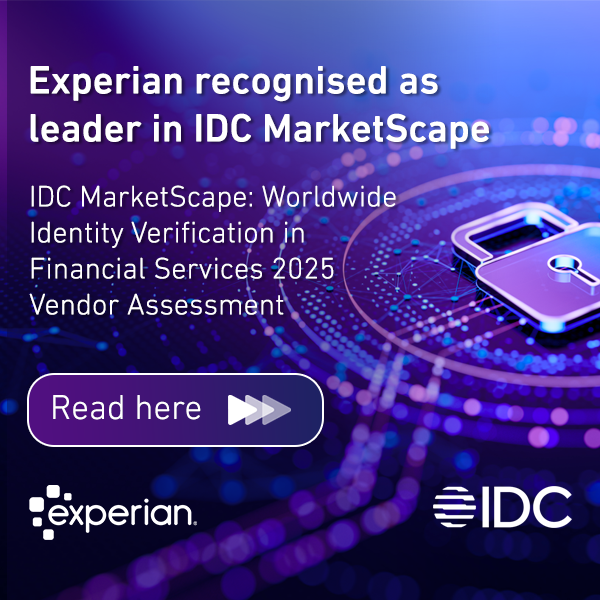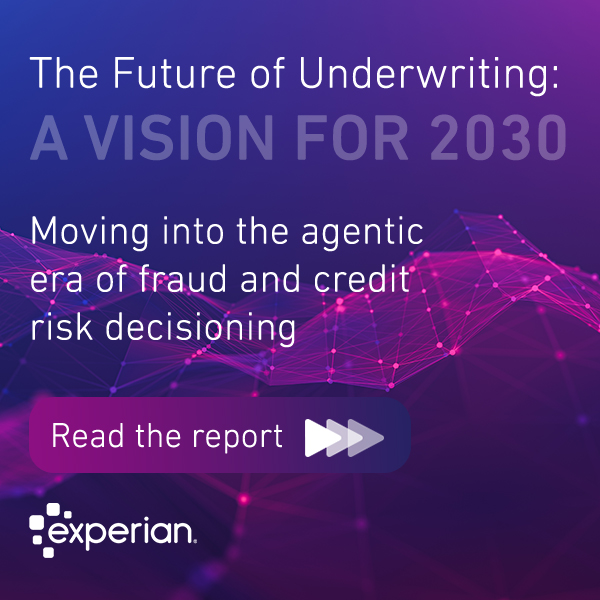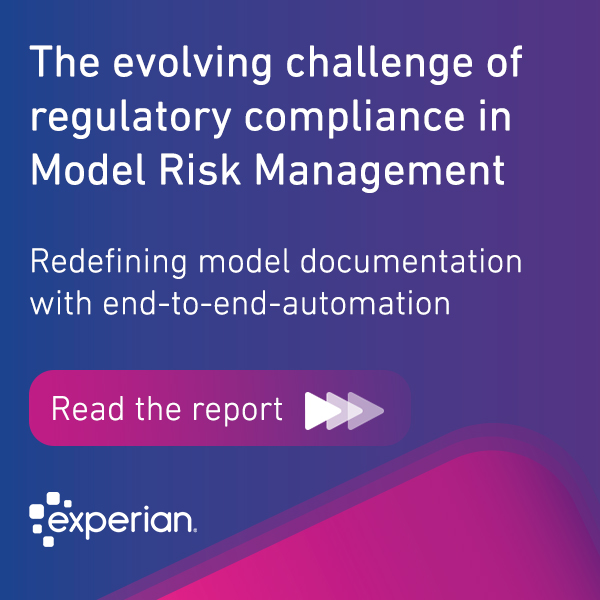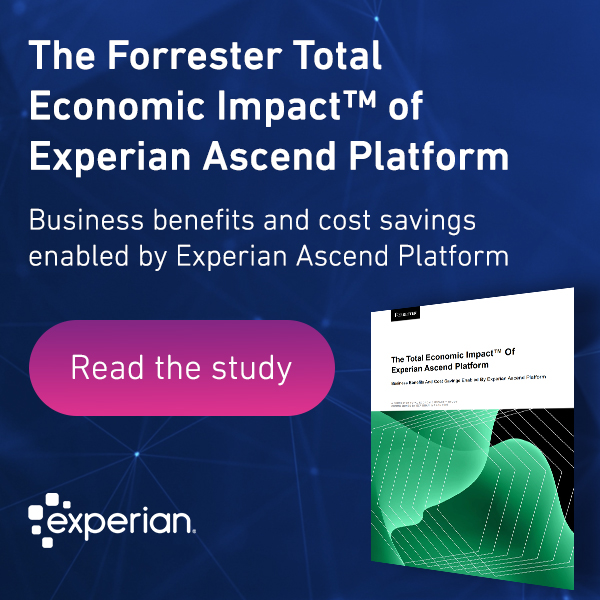Monthly Archives: December 2020

Get the latest from our global experts with these top December headlines, including meeting the demand for digital, increasing consumer expectations, women leading artificial intelligence, and protecting against fraudsters over the holiday shopping season. Investment priorities to meet consumer demand for digital banking In this BAI Banking article, Chris Fletcher, SVP Decision Management & Cloud Services, explores the investment required of financial institutions to transform their use of data and analytics and deliver on credit risk strategies. What’s the proper path for better payments? In context to consumers’ digital expectations post-Covid-19, Progressive Grocer considers the future of payments in food retail and beyond – with contactless payment options already rolling out at a large drug store chain. Wisdom from the women leading the AI industry, with Laura Stoddart of Experian Authority Magazine speaks with Laura Stoddart, Data Scientist, about her career path, her experiences working on ethical AI and using emerging datasets to evaluate risk as well as her thoughts on the future of this industry. #TradeTalks: Increasing consumer demands and expectations Steve Wagner, Global Managing Director of Decision Analytics, joins Nasdaq’s Jill Malandrino to discuss recent research findings on increasing consumer demands and digital expectations, and ongoing considerations for a post-Covid-19 world. A holiday season like no other: What to know to guard your company against fraud Itay Levy, Forbes Councils member and CEO and Co-Founder of Identiq, provides his perspective on the increased preference for online shopping and the need to strike the right balance between customer experience and efforts to mitigate fraud. Stay in the know with our latest insights:

Check out the 10 most popular stories of 2020 that will help to kick-start your 2021. It includes a look back on how trends evolved throughout the past year, which trends will be durable in the new year, and what the global pandemic has taught us about creating meaningful relationships between consumers and businesses. Top 10 list of the best stories in 2020: 10. Model recalibration drives impactful results during constant change Banks have managed through stressed scenarios in the past but none have ever had to predict customer behavior in a pandemic. General indicators of risk or stress didn’t reveal enough about what was going on in customer portfolios. Active model calibration in our current situation had a measurable effect on approvals and expected losses but executives still needed to regain control over disrupted models. Read full article 9. Digitally managing your at-risk customers most impacted by Covid-19 Lenders felt a tremendous amount of pressure this year trying to help reduce the impact of the financial burden Covid-19 put on consumers by supporting payment forgiveness and deferment programs. This made it difficult, though, to understand changes in the credit profile of a previous solvent customer and mobilize their operations teams to service these good but at-risk customers. Read full article 8. The rising need for identity verification Consumers turned to digital when mass closures of businesses prevented in-person transactions. Even as some businesses re-opened with precautions in place, many consumers still felt it was safer to do business online emphasizing the importance of security and identity verification. But while some level of friction invokes a sense of security, too much or unnecessary friction had an adverse effect. Read full article 7. Proactively restructuring debt to help improve customer affordability At the beginning of the year, no one could accurately predict how the world would be impacted by Covid-19 or how long it would last. Customer affordability models shifted into unknown territory and businesses tried to figure out how to assess customer risk in this new context. Lenders relied on the customer data and insights available to them and needed them to work harder at anticipating changes. Read full article 6. Be mindful of these 3 strategies when engaging customers digitally The road to digital was already being paved when the pandemic started but consumers and businesses were pushed there to engage en masse this year. There were practical challenges that needed to be addressed in the short-term, like managing call volume with a remote workforce. But more importantly, it put the spotlight on massive areas in need of modernization, such as the management of liquidity and risk. Read full article 5. Banking trends and opportunities in the post-Covid-19 crisis era This year was marked by adaptation, resilience, and reflection – which can be said for our personal lives – but in the context of the banking industry, it created an opportunity to change or accelerate priorities. Moving operations to the cloud, making sure decision strategies are fit-for-purpose, and applying analytics in a more useful way are some of the stickier trends we’ll likely see continue in 2021. Read full article 4. Why consumer trust in the digital experience is so important in a pandemic era Despite the uncertainty of this past year, one thing remained certain – cultivating customer trust is critical to brand loyalty. Digital customer trust, however, required businesses to consider several specific factors that inform and build trust. Digital adoption was mistakenly considered the most important of those yet being treated fairly, customer recognition, and fraud prevention were stronger signals. Read full article 3. Game changers: Women in Artificial Intelligence Artificial intelligence offers a lot of value, especially when used to better support customers’ financial needs. As more businesses processed huge amounts of data with advanced analytics and AI this year, human oversight was key to ensure transparency and explainability. This “human element” was the inspiration for an article mini-series featuring five women who are making a real difference using AI innovation. Read full article 2. Digital transformation through cloud-first decisioning The credit and fraud risk decision management landscape changed this year – including how the customer journey is being redefined. Mounting consumer expectations for a better digital experience meant the front and back end of a business’ operations were no longer mutually exclusive. Cloud-based applications was the reset needed to move away from functional and product silos to focus on the customer. Read full article 1. Covid-19 as a gateway to fraud Fraudsters are opportunistic which exposed another ugly side of the pandemic throughout the year. As people and businesses moved to digital to engage with one another, criminals exposed weaknesses in the tools, processes, and systems used to protect those interactions. Investment in fraud prevention was already on the rise but steadily increased throughout the year as new fraud trends emerged. Read full article

The rise of digital decisioning software enables organizations to scale a similar level of personalization, offering customers what they need at the exact right time. And organizations that do it well dramatically improve the customer experience and drive loyalty and revenue in the process. But realizing this promise takes the right tools. The most effective decisioning platforms include a powerful combination of data, analytics, and technology. Equally important, the software must allow non-technical users to update and change strategies to better meet customer and organization needs without burdening IT. Good versus great From a credit risk perspective, there's a vast difference between good decisions and really great decisions. For many organizations, the current status quo still involves decisions made in silos, with business groups sitting in different locations (now even more so, given the prevalence of work-from-home). Creating usable predictive models and then putting them to use can take weeks or even months. What's more, changing the model often requires that business users make requests of perpetually overloaded IT teams. To be sure, the process eventually yields decisions. However, from the customer's POV, they may be slightly irrelevant or feel less than personal. On the business side, the model may lack essential data from across the organization or not yet include critical factors in a rapidly changing landscape. A great decision, on the other hand, benefits the customer and organization alike. Robust analytics enable the decisioning process to reflect the most relevant customer data, from websites they've recently browsed to purchases they've made. The decisions, as a result, reflect that thoughtfulness. They're immediately useful and relevant to customers, putting forth guidance and products when customers need it most. Exponential organizational value Improved customer experience is a key objective for many organizations. Digital decisioning can help further that goal while also providing returns in multiple other ways. For instance, an advanced digital decisioning platform enables organizations to pivot quickly in the face of crisis. Organizations can add new data sources and explore new models in rapid fashion, tailoring them to immediate demands. In doing so, they not only improve predictive power, but they also produce better decisions. The process allows companies to discover and launch new products, reach new markets, and surface early signs of trouble within customer segments. This past year, we witnessed first-hand how organizations leveraged digital decisioning to deftly navigate a challenging environment. For instance, one of our customers, a large bank, used the software to run simulations of new strategies it was considering in response to the pandemic. In doing so, the bank gleaned a better understanding of how the plan would impact its portfolio. The company was also able to identify areas of overlapping services and take proactive measures to eliminate duplication and reduce expenses at a critical time. The cumulative result of improved digital decisioning is an increased ability for companies to differentiate themselves from the crowd. This is true across industries and verticals, from innovating consumer financing for automotive companies to helping healthcare organizations better manage patient debt. That secret sauce Like the friend that really gets you, a great decisioning platform is invaluable. But what makes a platform rise to the top? As noted above, the ability to incorporate and integrate lots of high-quality data is essential. Timely customer data helps identify customer trends and fuels more accurate predictions of future behavior. Platforms should also take regulatory obligations, business constraints, and changing risk factors into account. Solutions that leverage advanced analytics can then transform an ever-growing body of data into decision insights. The software should capture the data used in making those thousands or millions of decisions and make it available real-time to business users, creating a continuous feedback loop. The latter ensures that businesses can stay relevant and nimble. Notably, leading digital decisioning platforms also prioritize the business user along with IT expertise. At a moment that demands quick responses and near real-time solutions to customer needs, business users also need the ability to design, build, test, and deploy strategies. The democratization of the software ensures that the organizations can experience a digital decisioning platform's full potential. In this new era, the organizations that deliver value across the customer journey will be the ones that thrive. Digital decisioning empowers organizations to manage costs and risk while keeping the focus on the customer. They can do this even as they grow, building healthier, more responsive companies with customers at the core of every decision. Related stories: Cloud-based decision management is a must for re-imagining the customer journey Impact of technology on changing business operations Digitally managing your at-risk customers most impacted by Covid-19

The need for advanced technologies, such as artificial intelligence, has surged in the wake of Covid-19. The strain of the pandemic on businesses and economies has created tension in operational models requiring a quick and dramatic response to this digital disruption. As transformation efforts continue, there are several considerations for the growing field of AI – including ethical AI, the need for diversity and gender balance, and striving to be consciously unbiased. This final post in our “Game Changers: Women in AI” series takes a deep dive into AI careers. Our experts share important lessons on how to thrive, including having mentors and sponsors, staying relevant with new related skills, understanding problems to be solved, believing in yourself and actively seeking growth opportunities. New to the Game Changers: Women in AI series? Read Part 1 - Game Changers: Women in AI Read Part 2 - Game Changers: Women in AI Q: What advice would you give to help other women in AI thrive? He: "I would suggest being brave. Don't be afraid of trying new things. Sometimes we fear we cannot do something, but once you try it you find it’s not very difficult, you can do it. You can do it very well. So, I think the first thing is just try it. Don’t be afraid of making mistakes. If you go this route, be confident. Women are very smart and competitive, but they may not recognize how good they are. Also, if you find that you may be interested in this area, find resources and see if this is something you want to dedicate yourself to. There are a lot of options online. Even a lot of the universities now offer their courses online. People also share code online, so there are lots of good resources to help you explore and start learning. Overall, remember to believe you can do it." Kazmi: "For everyone that wants to try AI, or if you’re already working here and want to remain in the industry and do good work, you have to keep yourself relevant — learning and keeping yourself updated with the newest research that's happening. There is no end to learning in this field. At the same time, you need to have business knowledge to truly understand a business problem statement and convert that to a data science problem statement, and then start developing solutions for it. I really think that women can be strong contributors in this regard by leveraging their management and analytical skills to bridge the gap between the two areas." Kung: "I think we all need to be ourselves and respect ourselves. You need to have a goal and work hard for it. I think it is the same for anyone who wants a successful career. You need to set a goal and work hard for it and you will achieve it. Really, it's all about working hard. Also, my experience in AI has included a lot of brilliant women, so I never really felt like this is a job for men vs. women. The truth is we want more people to understand what we are doing – that there are many great things we can do with data. It is not something to fear. It’s not this magical thing. It is statistics. It is computing. It's coding. It's everything good." Peters: "It's so important to reach out and look for both mentors and sponsors, and this can be at any age. Mentors are our sounding boards to help with career development. There's some overlap with sponsors, who are opening the doors and speaking about you on your behalf in order to accelerate the track to the next place that you want to be. Mentors and sponsors are good starting from a very young age – and I think that’s a critical aspect of bringing more women along. Find these folks, make those connections, nurture those relationships, and have those mentors and sponsors. I really think that's a key aspect. Also, women do not necessarily need their network to be all women. You need to find the best people positioned to help you in your journey." Stoddart: "Having a mentor is good, especially someone who's more senior in your target field. And, it doesn't necessarily have to be somebody who you're working with or somebody who's your boss. They can be from academia or a different company. It's nice to have the outside perspective. It’s also helpful to network – I’m using virtual events now. I’ve met a lot of women in data science through activities outside of my current role. There are so many opportunities beyond your day to day job. I try to have a few things going at once -- I'll mentor somebody, I'll have a side project or volunteering, and my full-time job as well. For example, for the social enterprise I'm working with, I'm getting experience forecasting. It's nice to give back, but it also makes you a stronger data scientist to work on these different projects." Q: Is there a person or experience you are grateful towards that helped set you on the path to where you are today? He: "First, after graduation, I got a job in transaction analytics, detecting fraud transactions in credit cards. Essentially, it has the same goal as other projects, understanding human behavior from large amounts of data. That's what amazed me and kind of drove me into this direction. After that, I got the job here at Experian and I was exposed to a lot of great innovations and projects." Kazmi: "In the eight and a half years I’ve been in the AI industry, I’ve had the opportunity to work with multiple organizations across different domains. Through this diverse experience, I’ve met and worked with women from different backgrounds both as leaders, as well as colleagues. I’ve seen successful women leaders from all walks of life – from different educational backgrounds, whether from computer science, engineering, mathematics, or economics management, et cetera, or even differing nationalities and ethnicities. It has been impactful to see successful women leaders cutting across industries and localities." Kung: "Professionally, the person that I'm grateful to is my first boss. He was a teacher for me and taught me a lot. Everything that I am today, everything that I do at work, professionally, he was who trained me for it. When I think of the professional Jennifer, I always think of him. I think in my whole career, everyone who was part of my path, they helped me somehow. Maybe in little ways, and maybe in some big ways, they all helped me." Peters: "There are so many people I am grateful to in my career. Overall, where I am today comes down to the opportunities I was given. I had the opportunity earlier on in a prior role to be exposed to big data and frameworks, an exciting precursor to my work with AI. Today, when I think about my work with fraud and identity, AI is such a critical piece of that. And it's becoming increasingly important as we apply these concepts into financial services. I’ve been able to join collaborative and innovative colleagues, fraud experts, in a unified quest to solve the fraud challenge." Stoddart: "I am grateful to the person who brought me into this department. He saw something in me, he understood that I really wanted to learn, and he created a position for me. They were not hiring for a data analyst at the time, so that was really energizing. Also, I don't look for positions that already exist, because if everybody applies for positions that exist, it’s limiting your scope. A lot of the things that I've obtained in my life, it's because I've been a bit brave and asked for it. Even if it's not there on a plate, here I am." Related stories: New Podcast from AI in Business: The evolution of the data business in the age of AI Game Changers: Women in AI (part 1) Game Changers: Women in AI (part 2) Yi He Yi He works as a data scientist in the Experian NA DataLab. She is dedicated to using machine learning and AI to extract information from large amounts of data to identify, understand and help people, and prevent fraud. She aims to bridge online and offline worlds by linking identity data from these unique sources. With a focus on minimizing friction to customers, Yi’s work helps organizations identify synthetic identities to avoid fraudulent applications. Recently, she contributed to a Covid Outlook & Response Evaluator (CORE) Model – a “heat map” of geographic populations across the U.S. most susceptible to severe cases of Covid-19. Deeba Kazmi In her role as a data scientist at the Experian APAC DataLab, Deeba Kazmi is focused on solving business problems with analytics, including the development of consumer and small to medium enterprise credit risk models that leverage alternative data. Deeba is passionately focused on leveraging AI to create solutions that can help address issues faced by developing markets. Most prominently, this work includes her data science leadership contributions to solving a crucial economic and societal problem – financial inclusion. This effort is helping disadvantaged socio-economic consumer groups gain access to vital credit and financial services by leveraging the power of technology to deliver better outcomes. Jennifer Kung Jennifer Kung is an analytics consultant for Serasa Experian Decision Analytics, where she combines her knowledge of financial services with her data analysis expertise. Jennifer aims to harness the power of data through robust, descriptive and predictive analytical solutions to help clients realize the benefits of the massive amounts of data available to them. She recognizes the magnificence in powering discoveries through data analysis and enjoys revealing these capabilities to businesses who can benefit from these robust, yet approachable solutions. Jennifer enjoys knowing that her work helps to simplify and accelerate decisions that consumers rely on at important times in their life. Kathleen Peters Kathleen Peters leads innovation and business strategy for Decision Analytics in North America. As the prior Head of North America Fraud & Identity business, Kathleen is well-recognized as an identity industry innovator, being named a “Top 100 Influencer in Identity” by One World Identity the last two years. As of 2020, Kathleen was named Chief Innovation Officer for Decision Analytics. Kathleen and her team rely on the power of AI to continuously find new ways to solve customer challenges by defining product strategies, new paths to market and investment priorities. Underlying these efforts is a key focus on the ethical use of technology and the need to be consciously unbiased. Laura Stoddart Laura Stoddart is a physicist turned data scientist who works at the Experian DataLab in London. From her first exposure to AI, she recognized how quickly it can have an impact on the world, which has driven her to get and stay involved in the industry – both professionally and personally. Laura’s recent work has focused on ethical AI, having recently contributed to her first paper addressing the removal of bias from models. In addition, she is concentrated on leveraging emerging datasets to evaluate risk. Outside the DataLab, Laura also volunteers her data science skills to good causes such as Bankuet and helps expose others to the world of AI through mentoring.

In this episode of Insights in Action, we talk about currently available technology used in machine learning, including APIs, SaaS and IaaS. Businesses of all sizes can leverage these methods to build the right cloud ecosystem and accelerate their AI operations. Experian Global Decision Analytics experts Mark Spiteri, SVP of Software Engineering, and Srikanth Geedipalli, SVP of Analytics & AI Products, share practical advice to help businesses identify core capabilities needed to get MLOps right. Get useful insights about: Ways for businesses to leverage AI and machine learning to drive greater impact and ultimately improve the lives of consumers How to use AI and advanced analytics to help manage your business in the current marketplace Setting business goals and strategic plans to operationalize and deploy your machine learning models at scale The 4Cs of a successful MLOps framework Real-life examples of businesses set for success with MLOps Listen now: Related stories: New Tech Talks Daily Podcast: Machine learning and AI in business — investment trends pre- and post-pandemic Impact of technology on changing business operations Game changers: Women in artificial intelligence

In this Tech Talks Daily podcast, Shri Santhanam, Executive Vice President and General Manager of Global Analytics and AI, speaks with podcaster Neil C. Hughes. Santhanam discusses trends based on data from our recent Global Insights Report, which found that nearly 70% of businesses have used either machine learning or AI in business management and almost 60% of businesses are increasing their budget for analytics and customer creditworthiness in the next 12 months. Here are highlights from this 21-minute podcast: Covid-19 disruption has become a catalyst for breaking largely mindset-based transformation barriers, leading to unprecedented digital disruption and adoption of advanced technologies Experian global research confirms a fundamental change in the way businesses and consumers think about digital adoption and experiences Businesses will continue to increase budgets to grow data science resources to align their intent with their capacity Consumers have high expectations and little patience through their digital engagements, with 1/3 of customers only willing to wait 30 secs or less before abandoning an online transaction The greatest success from analytics and AI in business is realized when teams are focused and agile in their approach Listen now: Get more insights from these podcasts featuring Shri Santhanam: New Podcast from AI in Business: The evolution of the data business in the age of AI What is the right approach to AI and analytics for your business? Four fundamental considerations Forbes Podcast: Looking to Data, Analytics and AI to plan the way forward

Over the past fifteen years, identity-related fraud has evolved towards more automation, in the form of scripted attacks and bot attacks, as well as more sophisticated phishing attacks. Credential harvesting was the most prevalent form of fraud in the early 2000s, while recently, the global coronavirus pandemic has accelerated sophisticated attacks such as account opening fraud and account takeover fraud. This infographic showcases the evolution of fraud from 2005 to 2020, offering a complete view of different types of fraud and the most effective identity management and fraud prevention solutions to keep ahead of fraudsters over time: Related stories: Fraud trends during a very pandemic holiday Getting to grips with the shifting fraud landscape What your customers say about opening new accounts online during Covid-19

Consumer demand has shaped the way businesses worldwide have adjusted or intend to adjust operations and investments throughout the pandemic. Businesses that have struggled to meet the new expectations of consumers will need to meet ever-changing conditions with careful investment and data-driven analyses. Experian’s latest Global Insights Report shows two-thirds of consumers globally have remained loyal to their favorite brands during the pandemic. Brand loyalty was found to be the highest in India, at 80%, and lowest in France, with a bit more than half, at 57%. However, loyalty may not be a given going forward. Competitive differentiation is founded on how you engage customers, at every interaction. Our research shows that loyalty is intrinsically linked to trust, security and convenience. Payment system providers, such as PayPal, have retained the top spot for customer loyalty for three years in a row, but there continues to be movement among the remaining top five industries. This fluctuation, indicative of consumer preferences and behaviors, is fueled by the varying speed at which businesses globally are transforming front- and back-end systems. Particularly, this holds true for the pace of digitization of credit risk and fraud risk operations. Leverage data to retain loyalty Consumers have higher expectations than ever before, and businesses need to meet or exceed these expectations by adapting to correlate with the dynamic nature of the customer journey throughout the continuing pandemic. The report also found that 60% of people have higher expectations of their digital experience than before Covid-19, increasing the need for businesses to make sure that they are leveraging data to benefit their customers, providing secure and convenient digital experiences. Although most customers have shifted to digital and prefer the conveniences of online, mobile and contactless transactions, concerns over data security remain. In response, businesses need to carefully navigate customer experiences to ease apprehension. A great example is the trust, and therefore loyalty, that can be established by using customer data for identity authentication. Customers gain protection while enjoying a hassle-free experience that is non-threatening and transparent. Some businesses recognize these needs, with 40% reporting they are doing a better job communicating how customer data is used to enhance the customer experience, protect consumer information and personalize products and services. Integrating data, analytics and technology Our survey also found that only 24% of businesses are deliberately making changes to their digital customer journey. However, many of them have intentions of making changes and are increasing their budgets in order to do so. Three of the top five solutions businesses are using to help improve the customer journey are designed for driving insights into faster customer decisions. Of these top five solutions, the use of AI to improve customer decisions ranks first amongst banks, payment providers, and retailers ranks first. Companies who are, or plan to, accelerate the implementation of AI can make faster, smarter data-driven decisions to better serve consumers. The key to better serving customers lies in a business’s ability to integrate data and decisioning technology to deliver fast and relevant products and services. In fact, the study found that one in three consumers are only willing to wait 30 seconds or less before abandoning an online transaction, including accessing their bank accounts. With such a short window to keep the customer engaged, faster decision making is imperative to not only retaining a customer’s loyalty on a long-term basis but getting them to commit to a transaction once. Businesses, particularly retailers and financial services who implement the necessary technologies will help move economies from sustainability mode towards a future of growth but cannot do so without continued consumer demand. While customer loyalty does remain, it is up to businesses to adapt and accommodate to retain, and potentially increase the impact of these adjustments. Regardless of where they’re transacting, consumers expect a secure, convenient experience—and they’ll quickly abandon transactions if they’re let down. So, businesses must keep their focus on transformation. Discover more insights from our longitudinal study of the impact of Covid-19 on businesses and consumers.

In this episode of Insights in Action, Mark Spiteri, SVP of Software Engineering, and Mariyan Dichev, Manager of Software Engineering, cover what it takes to build award-winning technology teams. They explore the dynamics of their work and how the ability to automate the decision-making process alongside the customer journey has become paramount in today’s dynamic environment. Mark and Mariyan walk us through their own transformational journey to enable organizations of all sizes to gain direct access to advanced tools and actionable insights. They give background on Experian Global Decision Analytics Technology Team winning AIBEST's Project of the Year 2020 Award in recognition of the strides they have made to enable quick, accurate, and effective credit decisions. Some of the topics discussed in this 20-minute podcast: Practical advice to get industry recognition for outstanding information technology processes and results. How to navigate the IT talent crisis successfully. What IT executives should look for when hiring for their teams. Tips on identifying the right fit: 3 types of people every award-winning engineering and software development team needs. How to manage and grow high-performing technology teams.




